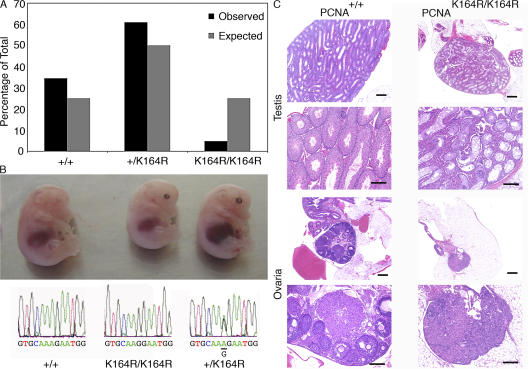Figure 3.
Homozygous PCNAK164R mice are born at sub-Mendelian frequency and are infertile. (A) 397 offspring from 70 intercrosses between heterozygous PCNAK164R mutants were genotyped. In contrast to the 25% expected homozygous mutants, only 5% were observed. Wild-type and heterozygous mice were born at a frequency of 34 and 61%, respectively. (B) Embryos from E14.5 intercrosses between heterozygous PCNAK164R mutants with the respective Applied Biosystems sequencing profile of their PCNA alleles are shown. (C) Failure of germ cell development in homozygous PCNAK164R mice. Histological sections of testis and ovary of 3-mo-old mice. Bars: (small) 500 μm; (large) 200 μm. (top four panels) Control or PCNAK164R testes. The control testis shows all stages of normal spermatogenesis whereas PCNAK164R testes show atrophy of spermatogenesis: only Sertoli cells are found, no sperm is detected. The PCNAK164R testes show strong hyperplasia of Leydig cells. (bottom four panels) The normal ovary contains numerous follicles in all stages of development. The PCNAK164R ovary consists predominantly of interstitial cells.

